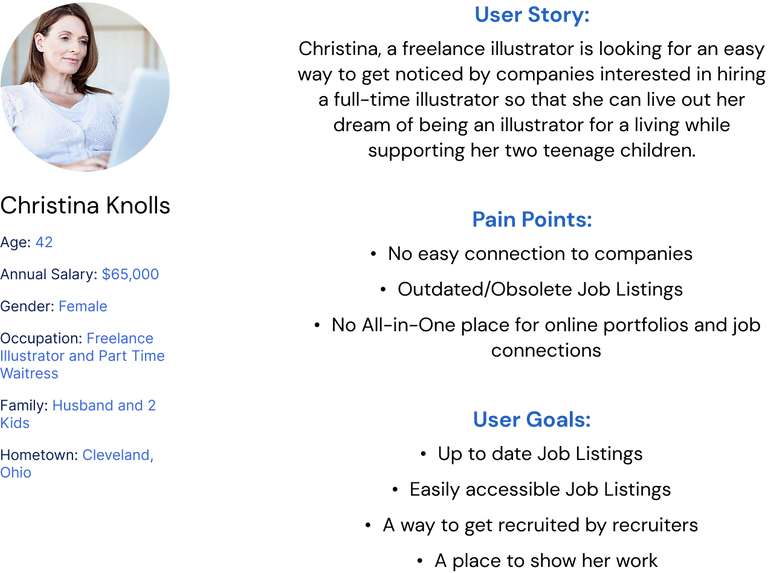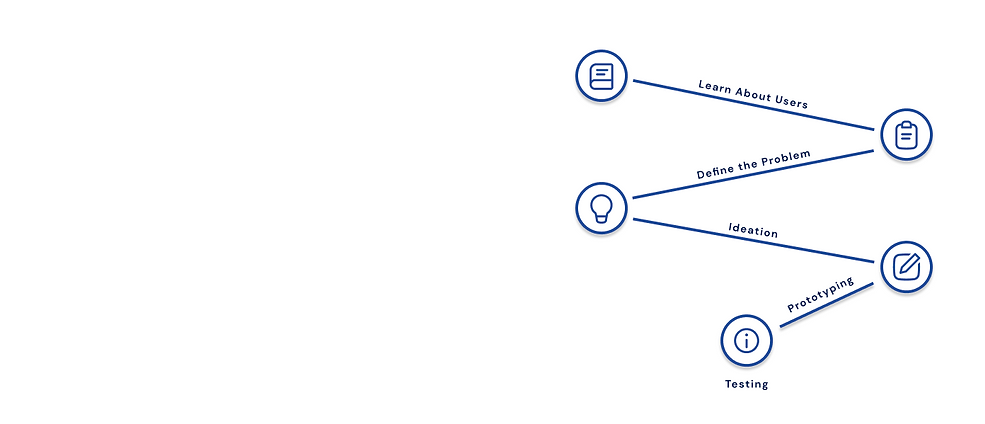
My Role
Description
Develop an application that will allow artists to:
- Find A Job
- Find A Client
- Sell Their Artwork
- Build an online presence and portfolio
When
January 2022 - July 2022
Who
The Mission of Art Cloud is to be the bridge between artists/designers and their clients, customers and employers. This project is the User Experience Design for the Art Cloud Mobile Application Platform.
User Research - Steven King
UI Design - Steven King
UX Design - Steven King
Prototyping - Steven King
The Problem
Most designers and artists struggle to build the connections/reputation they need to create a career in their respective fields.
Why is this problem important?
"Why is it so hard to get commissions and find art related work?"
I personally wanted to be an artist at one point and ran into a consistent problem that most artists run into. They struggle to reach the audience that they are looking for. Getting work as an artist is quite a challenge even in the age of social media which does make it easier. Most artists use multiple platforms to improve their chances of reaching their target audiences. Some just want to get a stable job making artwork without the entrepreneurial aspect of it. There are some solutions but they only cater to a very specific niche. Many will quit being an artist if they don't see the potential of actually succeeding as one. This is why this project is important. To keep these artists and designers dream alive.

How can Art Cloud solve the problem?
This Application allows for users to:
-
Network with other artists and businesses
-
Generate a Following
-
Sell Their Physical and Digital Work
-
Apply for Jobs
-
Discover new design talents
-
Get design inspiration
Goals of the Application
1. Simplify the communication between artists/designers and their clients/customers/employers.
2. Showcase artists’ work in a way that will reach their target audience.
3. Improve upon the existing social media formats to create a more enjoyable experience.
Research
“When faced with the question of whether to seek out gallery representation, attempt to sell art on their own, or keep a day job while hustling to make art on the side, many emerging visual artists have no firm guide posts to look to on their journey.”
- Willa Köerner
ArtNet ran a study in 2018 on artist financial stability and here are some of the results:
1. 60% of the artists surveyed make less than $30,000 a year (Less than a livable wage depending on where they live)
2. 42% of the artists surveyed have other jobs on top of being an artist
3. 12% of the artists surveyed count gallery sales among their top 3 sources of income

I also interviewed a few artists in the New York Metropolitan Area and here is what one of them had to say in regard to the state of building a community around their art.
"Twitter is going downhill and Instagram is following as well with new policies for tools being locked behind pay walls...a platform with selling and getting work would sound like a dream."
Art/Design is meant to be a passion but with the lack of a path to build their career as an art or a designer. Being locked by pay walls or confusing convoluted algorithms really hinders their growth not only in their career but an artist themselves.
Users and Their Needs
Meet Christina...

1. Artists & Designers
- A platform that allows an artist/designer to build a reputation and reach their target audience
- A place to sell art to the everyday art fan
- A place to find listings for potential jobs both freelance and permanent positions
Meet Janine...

2. Businesses & Corporations
- A online profile that allows for them to see an artist/designer's portfolio, resume and online reputation
- A way to easily communicate with artists/designers directly
- A way to discover new artists/designers that they may be interested in working with
Meet Jeffery...

3. Art Customers
- A way to easily see and purchase digital or physical art
- A way to communicate with artists to commission them

The
Design
Process
Ideation Process
How might we solve the problem?
Selling Art Via Art Cloud
-
What are we selling?
-
Is it Digital? Is it Physical?
-
How can we make it possible to sell these products?
-
How do we make an experience that would make it easy for someone to buy art?
Job Listings
-
What types of Jobs are artists/designers trying to get?
-
How can we make it easy for them to find their dream position?
-
How can we make it easy for companies/clients to make job listings?
Profiles
-
How can we make fun yet professional profiles for artists?
-
How can we keep the familiarity of common social media platforms in our profile designs?
-
How can we make an artist/designer's resume and portfolio easily accessible from the Profile Page?
Discover Tab
-
How can we create a section that allows a creative to be found by their audience?
-
How can users scroll through other users' work?
-
How can we retain users' attention with this section?
The Shop is a place made to allow people to buy art both digital and physical. Any products could be purchased through the application easily using a Cart system which is very familiar to most people. Physical purchases ask for shipping details while digital purchases go to the Downloads section in the settings of the application.
The Jobs Tab is a place where creative positions both freelance and permanent positions are made available to artists and designers. The listings will be made by the client or the company allowing them to create a detailed description of what they are looking for. Filters will be made to fit location, working environments (On Site/Hybrid/Remote), experience level and more.
The Profile Page will allow for users to show their work in the normal format of most popular social media platforms such as Instagram and Tiktok. There will be buttons just below the Profile Photo which will link to an artist's resume, portfolio and to directly message the user.
The Discover tab is a page that allows all users to discover new and upcoming artists/designers. It features 3 artists/designers who have received the most attention in the past week. It also shows the most popular hashtags, the most underused hashtags and hashtags that relate to you. Once opened, you can follow a hashtag to have those posts show up on your Home Feed.
Wireframing & Prototyping







The wireframing process for this was extensive since it is an entire applications UI/UX being created. Working off of some basic frameworks from other designs and common social media UI, I made some Mid-Fidelity wireframes to get a chance to see how the Information Hierarchy would work and such. After I felt that the designs were up to snuff, I worked on developing color scheme, design system and the overall feel of the UI while developing High Fidelity Wireframes.

One thing I love about UX Design is the quality control necessary to make a good product. As you can see from the design above, my original wireframe didn't cut it. There were some issues that needed to be resolved, so I went back and made the changes necessary.







With a mobile application like this, I ultimately decided to draw inspiration from the UI format that is used for LinkedIn and Instagram. This can be considered to be a social media platform for artists, so the endless feed format seemed the best for content consumption for the user.
As you'll see when you explore the prototype, this application checks a lot of boxes without the process seeming complex or hard to use.
In hindsight, I think I would've spent more time studying other social media platforms' UI to see what problems users could potentially run into and solve them in Art Cloud's UI. I plan to periodically make changes to the UI/UX as I learn more about my users and about UX Design in general since there is a constant need to improve.
Overall, the UI of this application is definitely unique in comparison to other applications but the fundamentals of the app is still in familiar territory for many users.
The design is quite ambitious in some cases, but it is definitely feasible. The idea was to have the user feel like they are actually sifting through art in the clouds. To make sure that it was still feasible by code, I opted not to give any animation for the clouds and such since this will be used on a mobile device which has weaker processing speeds and such in comparison to a computer.
Were we successful?
Let's look back at the survey done by ArtNet:
1. 60% of the artists surveyed make less than $30,000 a year (Less than a livable wage depending on where they live)
2. 42% of the artists surveyed have other jobs on top of being an artist
3. 12% of the artists surveyed count gallery sales among their top 3 sources of income
The only way we will know if we were successful is to do our own surveys and set realistic goals. What are some realistic goals?
1. 40% of the artists surveyed make less than $30,000 a year
2. 30% of the artists surveyed have other jobs on top of being an artist
3. 35% of the artists surveyed count gallery sales among their top 3 sources of income
These are some realistic goals that can be worked toward and achieved!
Reflection
I truly believe in transparency and how important it is. This was my first portfolio project in terms of UX Design. I developed the UX/UI while self-learning. It is interesting how when I am writing this, it has been just over a year since I started this project and how far I've come.
Reflecting back on my process, I would've made so many changes to what I did and take more time to get things right. Here are a couple of things that I personally learned from this project moving forward.
1. Sometimes I let the Designer in me get out too quickly. I was just getting into Figma, and I was excited to learn about that program. I've learned that my own personal excitement could hinder a design and that I need to think clearly and make patient and informed decisions in order to create the best design for my users.
2. I would've done more research. Although my research was valid, I would've done more to see more into my user's mind. I would've researched what issues people have when they look to hire a designer or what issues they run into when buying creative products. I would've asked more How Might We's and then focus on solving the biggest and most prevalent problem.
3. Thinking back now, I should've done more research in regard to the other social media platforms I wanted to emulate. A prime example is the Shop Page. Although the design fulfills its purpose, I should've looked into the big E-Commerce applications such as Amazon, Walmart, Ebay, etc. I would've followed their UI fundamentals and use it as inspiration to improve upon my own UI.
I am happy with the result that came from this Case Study and as you can see, there is always a lot of room to improve because in UX there is no such thing as a perfect product. It can always be better.